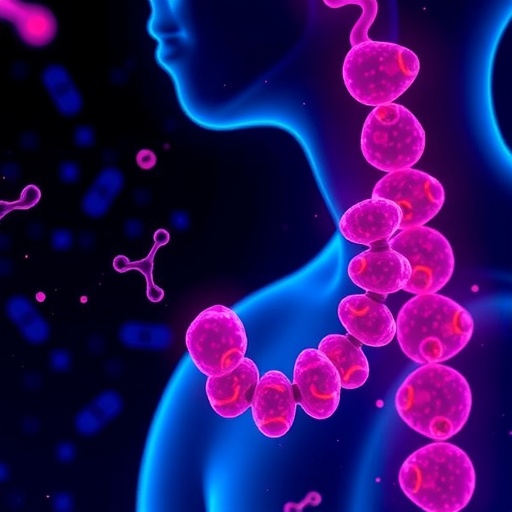Recent inquiries into the treatment of esophageal squamous cell carcinoma (ESCC) have unveiled remarkable insights into the mechanisms behind tumor progression and potential therapeutic interventions. A new study led by Zhou, Wang, and Zhao establishes the role of Chelerythrine in inhibiting the proliferation and spread of this aggressive cancer type. Their research opens up promising avenues for understanding how mitophagy—the process by which damaged mitochondria are selectively degraded—plays a critical part in cancer biology.
Esophageal squamous cell carcinoma is notorious for its poor prognosis and high mortality rates, particularly in advanced stages. The complexity of its pathophysiology, coupled with limited treatment options, underscores the urgent need for innovative therapies. As researchers delve deeper into the cellular mechanisms of cancer progression, the identification of mitophagy’s role has emerged as a significant area of interest. The regulation of this process could reveal essential strategies for intervention and control of cancer spread.
Chelerythrine is a natural compound derived from the plant Chelidonium majus and has previously demonstrated various biological activities, including anti-inflammatory and anti-cancer properties. However, its specific effects on ESCC and underlying mechanisms had not been thoroughly explored prior to this research. By employing a comprehensive set of experiments, the researchers sought to elucidate how Chelerythrine influences cell viability, apoptosis, and mitophagy in ESCC cell lines.
The study employed an array of methodologies, including in vitro assays to assess cell proliferation, flow cytometry for apoptosis analysis, and confocal microscopy to visualize mitochondrial dynamics. The results revealed that Chelerythrine significantly inhibits the growth of ESCC cells while inducing apoptosis in a dose-dependent manner. This dual action is crucial, as it not only prevents cells from dividing but also triggers their programmed death, a desirable outcome in cancer treatment.
One of the pivotal findings of the study is the association between Chelerythrine and the modulation of the PINK1-Parkin pathway, which is integral to the regulation of mitophagy. PINK1 (PTEN-induced putative kinase 1) acts as a sentinel within the mitochondrial landscape, and when mitochondrial damage occurs, it coordinates the recruitment of Parkin, an E3 ubiquitin ligase. Together, they facilitate the degradation of dysfunctional mitochondria, thereby maintaining cellular health and preventing the accumulation of cellular damage that can lead to cancer progression.
The research demonstrated that Chelerythrine promotes the activation of the PINK1-Parkin pathway, leading to enhanced mitophagy. This process not only improves the quality of mitochondria within the cell but also diminishes the available energy resources for cancer cell survival and proliferation. Consequently, by harnessing the natural properties of Chelerythrine, there exists a potential therapeutic strategy that targets the metabolic vulnerabilities of ESCC cells.
Furthermore, the study provides insight into the molecular mechanisms by which Chelerythrine influences signaling pathways associated with apoptosis and cell survival. Through the activation of key proteins involved in the regulation of these processes, researchers were able to delineate a clearer pathway linking Chelerythrine to its anti-cancer effects. Understanding this complex interplay is significant in the context of developing targeted therapies that could synergize with existing treatment modalities.
The implications of this research extend beyond just ESCC, as the role of mitophagy is increasingly recognized across various cancers. The ability of Chelerythrine to induce mitophagy suggests that similar compounds could pave the way for breakthroughs in other malignancies characterized by mitochondrial dysfunction. Future studies will be essential to explore the broader applicability of these findings and the potential for developing novel therapeutic agents.
Clinical translation of these findings will require rigorous testing and validation through preclinical and clinical trials. The promising early data provide a compelling case for the exploration of Chelerythrine as a viable treatment strategy in the fight against ESCC. However, the journey from bench to bedside entails overcoming significant challenges related to drug formulation, dosing, and understanding patient-specific responses.
Moreover, as researchers assess the translational potential of Chelerythrine, it will be critical to establish its safety profile and efficacy within the context of combination therapies. Integrating this compound with existing treatment regimens might enhance overall effectiveness and reduce resistance, an ongoing challenge in cancer therapeutics.
Nevertheless, the research highlights the critical need for continued exploration of natural compounds as potential cancer therapies. The findings serve as a reminder that nature often harbors untapped resources that could provide innovative solutions to pressing medical challenges. As the scientific community embraces these discoveries, it is imperative to orchestrate collaborative efforts that accelerate the journey of these compounds from the lab into clinical settings.
In summary, the study conducted by Zhou and colleagues introduces a groundbreaking narrative that intertwines Chelerythrine’s potential as a therapeutic agent with the vital processes of mitophagy and apoptotic regulation in ESCC. As this narrative unfolds, it exemplifies the intersection of traditional knowledge and modern science, showcasing the promise of natural products in unraveling the complexities of cancer treatment.
The road ahead is adorned with possibilities, as continued investigation into the intersections of cancer metabolism, mitochondrial function, and targeted therapy holds great promise. With each piece of research, we draw closer to a future where esophageal squamous cell carcinoma, and indeed many cancers, can be effectively managed or even cured, transforming the landscape of cancer therapy as we know it.
As we advance, the challenge will remain to bridge laboratory discoveries with clinical realities. The journey from initial discovery to therapeutic application is fraught with hurdles, but the dedication to understanding the underlying mechanisms of diseases like ESCC remains the beacon of hope for researchers and patients alike. With the momentum gained from this research, the promise of harnessing the power of natural compounds like Chelerythrine could lead to significant breakthroughs in the quest for effective cancer therapies.
The vital questions continue to drive the research narrative forward: Can we maximize the potential of mitophagy modulation? Are there synergistic combinations that could amplify the effects of Chelerythrine or similar compounds? The answers to these questions will undoubtedly pave the way for novel treatments that could change the face of oncology.
In conclusion, this research provides compelling evidence regarding the role of Chelerythrine in ESCC progression through PINK1-Parkin-mediated mitophagy. It serves as a vital stepping stone for future investigations aimed at unraveling the complexities of cancer biology and developing innovative treatments that can improve outcomes for patients facing this formidable disease.
Subject of Research: Esophageal Squamous Cell Carcinoma and Mitophagy
Article Title: Chelerythrine inhibits esophageal squamous cell carcinoma progression via PINK1-Parkin-mediated mitophagy
Article References: Zhou, Y., Wang, Z., Zhao, H. et al. Chelerythrine inhibits esophageal squamous cell carcinoma progression via PINK1-Parkin-mediated mitophagy. J Transl Med 23, 1116 (2025). https://doi.org/10.1186/s12967-025-07025-w
Image Credits: AI Generated
DOI: 10.1186/s12967-025-07025-w
Keywords: Chelerythrine, Esophageal Squamous Cell Carcinoma, PINK1, Parkin, Mitophagy, Cancer Therapy
Tags: anti-cancer properties of Chelerythrinecellular mechanisms in cancer biologyChelerythrine and esophageal canceresophageal squamous cell carcinoma researchhigh mortality rates of ESCCinnovative therapies for esophageal cancermechanisms of cancer cell proliferationmitophagy in cancer treatmentnatural compounds in cancer therapyplant-derived anti-cancer compoundstherapeutic interventions for cancer controltumor progression inhibition strategies





